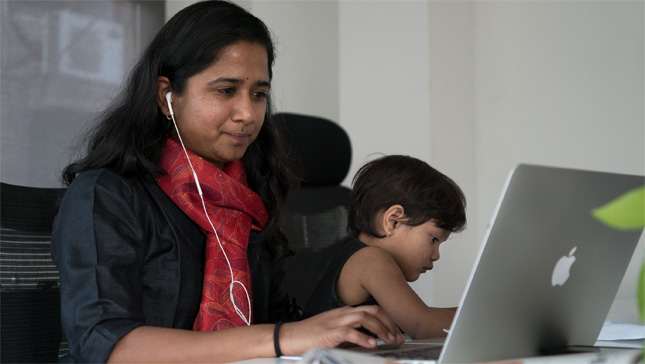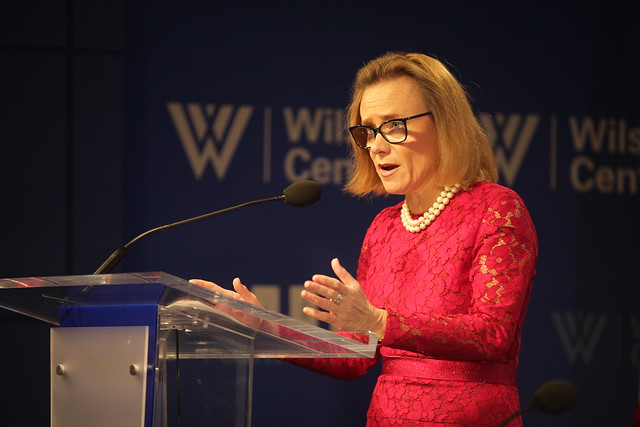-
The Costs of Caring: Balancing the Burden of Caregiving for Women and Men
April 4, 2018 By Yuval Cohen
“The act of caregiving has unique impacts on women, in terms of economic, emotional, and physical well-being,” said Dr. Belén Garijo, the CEO for healthcare and executive board member of Merck KGaA, Darmstadt, Germany, at a recent Wilson Center event.
What Does Caregiving Really Look Like?
“Caregiving is an issue that affects people of all different backgrounds—men and women,” said C. Grace Whiting, president of the National Alliance for Caregiving (NAC). “We are really talking about caregiving across a lifespan.”
Sixty percent of caregivers for someone who is ill or who has a disability are women, according to a study conducted by NAC and the American Association of Retired Persons (AARP). A survey conducted on behalf of EMD Serono, a business of Merck KGaA in the United States, found that a quarter of female unpaid caregivers spend five to nine hours outside of their regular jobs providing care in an average week.
While younger generations are moving towards shared responsibility for caregiving, the burden continues to rest on the shoulders of society’s women—especially women of color. “African American women are 50 percent more likely to have a baby born too sick and too soon,” said Stacey D. Stewart, president of the March of Dimes, resulting in a greater need for caregiving support.
“[The U.S.] government really provides very little support or incentives to address the needs that families have,” said Stewart, especially if the family has the added financial burden of caring for a child born prematurely. Businesses, on the other hand, are progressing more rapidly, she said.
But while private sector progress is promising, the speakers agreed that universal policies are fundamental.
What Policies Do We Need?
At Merck KGaA, Dr. Garijo and her colleagues have been reflecting internally on policies that encourage a more even distribution of the burden of caregiving among the company’s employees. “We have very recently set up a global task force that has been working over the last six months to understand what is preventing women from reaching the top,” she said.
Tackling unconscious bias, establishing mentorship and sponsorship programs, and allowing for flexible working schedules are some of the most important steps to take as a company, she said.
Assuring mothers’ rights to certain accommodations is necessary, according to Stewart. Part of this means making sure that women “can pump at work… [and] that they have places to safely and securely store milk at work.”
Panelists identified paid family leave as one of the most necessary policies that many countries around the world, including the United States, still lack. “This is an issue whose time has come,” said Whiting, “and you see on both sides of the aisle interest in finding a working paid family leave benefit that would be not only child care, but care across a lifespan.”
The burden of implementing paid leave is certainly larger for smaller employers. “The small businesses really illustrate how much we need policy,” said Gary Barker, president and chief executive officer of Promundo US. “This can’t be voluntary.”
Universal healthcare could possibly accelerate progress towards this policy. With a social insurance structure that everyone pays into, said Whiting, “the employer doesn’t have to shoulder the burden.”
Changing the Culture: Leadership and the Role of Men
Even in societies where paid parental leave is available, many fathers hesitate to take it. “We still have an unconscious bias that men are [financial] providers,” said Barker, and that taking parental leave can limit the trajectories of their careers.
“I do think there has been a poverty of imagination,” he said. “No country in the world has a policy that says: ‘we believe that men can do 50 percent of the care work.’” Changing the culture around care can go a long way, once the policies are in place.
“We need to get the leadership of women, but we also need men at all levels saying, ‘[caregiving] is part of who I am and what I do,’” said Barker, making it the norm, not the exception.
“It’s more about the person at the top understanding the value of diversity and inclusion,” said Whiting, and “setting that tone for the rest of the people under their leadership.”
Strong leaders understand that investing in these policies gives them a competitive advantage, said Dr. Garijo, and “this is an investment that will be very well-returned.”
Sources: EMD Serono, Promundo, March of Dimes, Merck KGaA, Darmstadt, Germany, National Alliance for Caregiving, American Association of Retired Persons
Photo Credits: Durga Nandini, 36, heads communication of a well-known online petition platform. She talks about the need for gender-sensitive workplaces, equal parenting, and recognizing women’s vital role in the labour force. April 2018. Courtesy of ILO in Asia and the Pacific.
Topics: aging, caregiving, demography, development, Dot-Mom, economics, featured, From the Wilson Center, gender, global health, maternal health, media, video
 A Publication of the Stimson Center.
A Publication of the Stimson Center.




